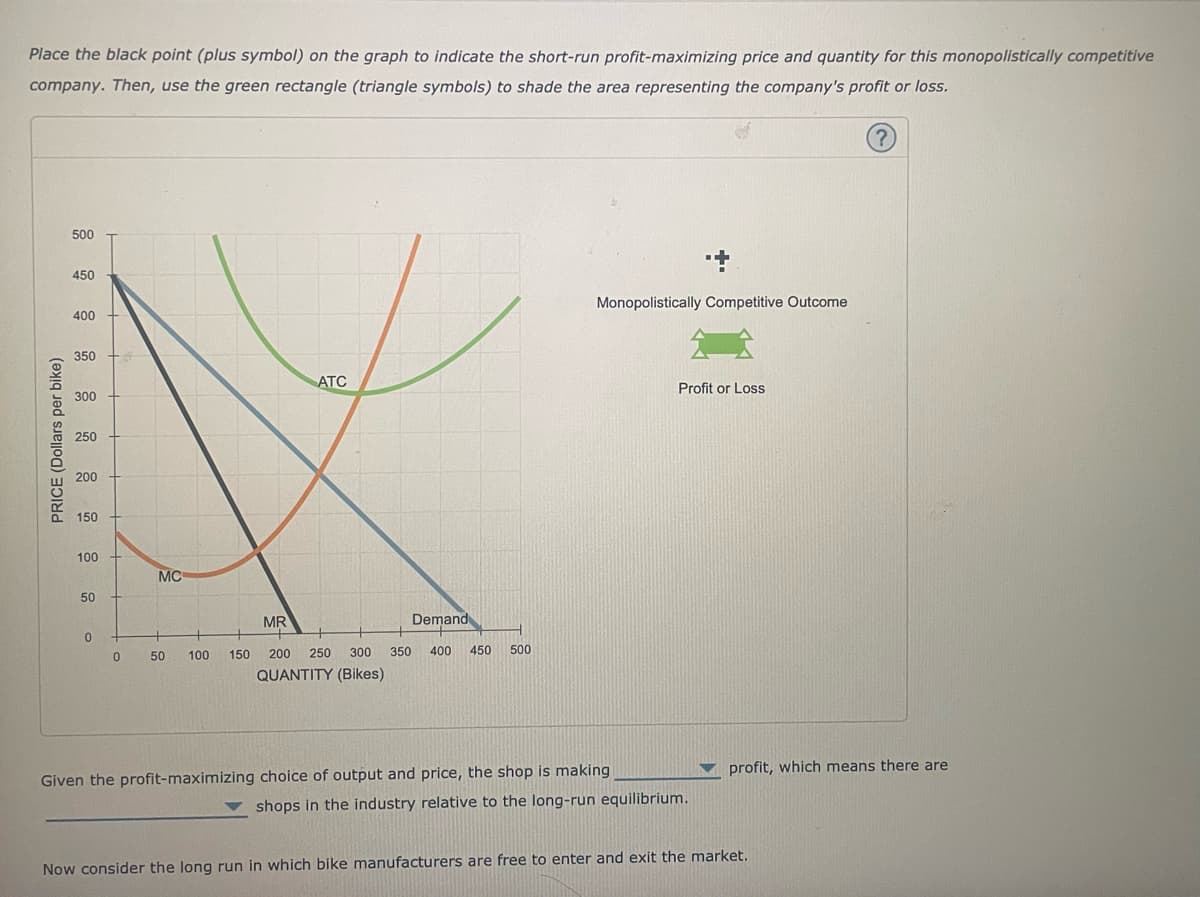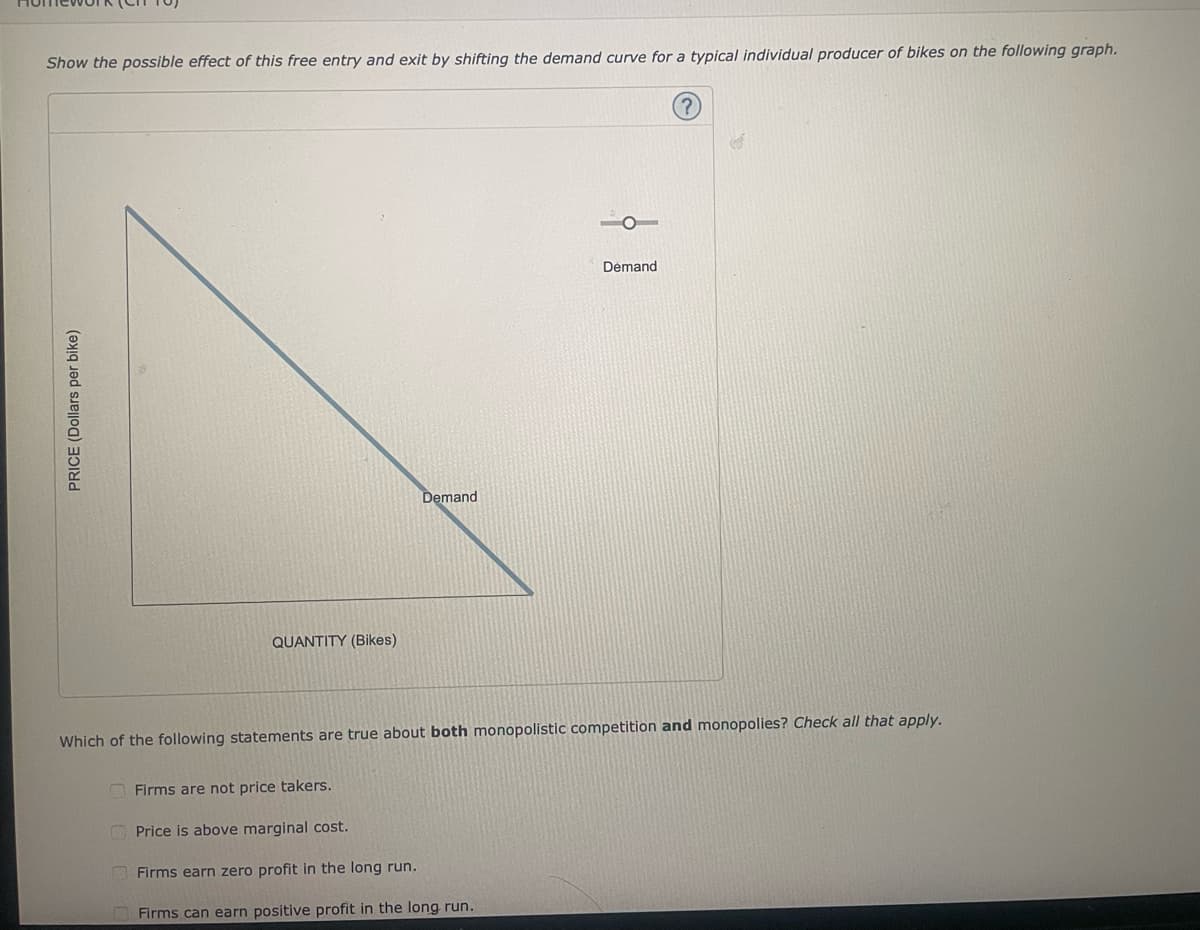Place the black point (plus symbol) on the graph to indicate the short-run profit-maximizing price and quantity for this monopolistically competitive company. Then, use the green rectangle (triangle symbols) to shade the area representing the company's profit or loss. 500 450 Monopolistically Competitive Outcome 400 350 ATC Profit or Loss 300 250 200 150 100 50 0 PRICE (Dollars per bike) MC MR Demand 400 0 50 100 450 500 200 250 300 350 QUANTITY (Bikes) Given the profit-maximizing choice of output and price, the shop is making shops in the industry relative to the long-run equilibrium. Now consider the long run in which bike manufacturers are free to enter and exit the market. 150 profit, which means there are
Place the black point (plus symbol) on the graph to indicate the short-run profit-maximizing price and quantity for this monopolistically competitive company. Then, use the green rectangle (triangle symbols) to shade the area representing the company's profit or loss. 500 450 Monopolistically Competitive Outcome 400 350 ATC Profit or Loss 300 250 200 150 100 50 0 PRICE (Dollars per bike) MC MR Demand 400 0 50 100 450 500 200 250 300 350 QUANTITY (Bikes) Given the profit-maximizing choice of output and price, the shop is making shops in the industry relative to the long-run equilibrium. Now consider the long run in which bike manufacturers are free to enter and exit the market. 150 profit, which means there are
Chapter14: Monopolistic Competition And Product Differentiation
Section: Chapter Questions
Problem 10P
Related questions
Question

Transcribed Image Text:Place the black point (plus symbol) on the graph to indicate the short-run profit-maximizing price and quantity for this monopolistically competitive
company. Then, use the green rectangle (triangle symbols) to shade the area representing the company's profit or loss.
500
450
Monopolistically Competitive Outcome
400
350
ATC
Profit or Loss
300
250
200
150
100
50
0
PRICE (Dollars per bike)
MC
MR
Demand
400
0
50
100
450 500
150 200 250 300 350
QUANTITY (Bikes)
Given the profit-maximizing choice of output and price, the shop is making
shops in the industry relative to the long-run equilibrium.
Now consider the long run in which bike manufacturers are free to enter and exit the market.
profit, which means there are

Transcribed Image Text:Show the possible effect of this free entry and exit by shifting the demand curve for a typical individual producer of bikes on the following graph.
Demand
PRICE (Dollars per bike)
Demand
QUANTITY (Bikes)
Which of the following statements are true about both monopolistic competition and monopolies? Check all that apply.
Firms are not price takers.
Price is above marginal cost.
Firms earn zero profit in the long run.
Firms can earn positive profit in the long run.
Expert Solution
This question has been solved!
Explore an expertly crafted, step-by-step solution for a thorough understanding of key concepts.
This is a popular solution!
Trending now
This is a popular solution!
Step by step
Solved in 3 steps with 3 images

Knowledge Booster
Learn more about
Need a deep-dive on the concept behind this application? Look no further. Learn more about this topic, economics and related others by exploring similar questions and additional content below.Recommended textbooks for you

Exploring Economics
Economics
ISBN:
9781544336329
Author:
Robert L. Sexton
Publisher:
SAGE Publications, Inc


Principles of Economics, 7th Edition (MindTap Cou…
Economics
ISBN:
9781285165875
Author:
N. Gregory Mankiw
Publisher:
Cengage Learning

Exploring Economics
Economics
ISBN:
9781544336329
Author:
Robert L. Sexton
Publisher:
SAGE Publications, Inc


Principles of Economics, 7th Edition (MindTap Cou…
Economics
ISBN:
9781285165875
Author:
N. Gregory Mankiw
Publisher:
Cengage Learning

Principles of Economics (MindTap Course List)
Economics
ISBN:
9781305585126
Author:
N. Gregory Mankiw
Publisher:
Cengage Learning

